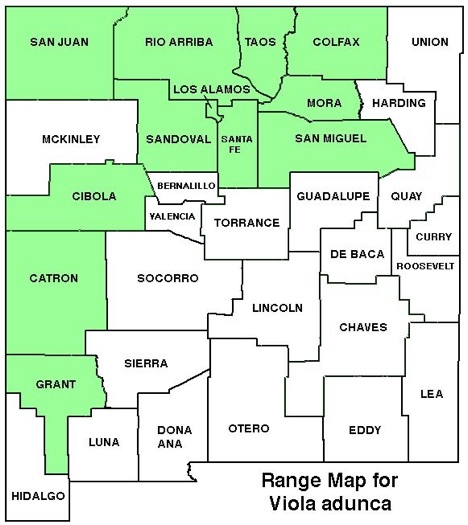WILDFLOWERS OF NEW MEXICO

If it’s a blue violet with a branching stem, it’s this species. Stems 3/4–12-inches (2–30 cm) long sprout from a dense clumps of leaves. Note the lower petal has a white throat with blue veins. Also called a Western Dog Violet and Sand Violet.
FLOWERS: April-August. Leafless flower stems to 4-inches long (10 cm) rise above the leaves. Pale blue to deep violet flowers 1/4–5/8-inch (5–15 mm) long have 5 petals; lateral 2 are white-bearded; lowest petal has purple lines and an elongated rear spur straight, curved, or hooked at tip. The upper 4 petals often curl backwards.
LEAVES: Basal and alternate on the stem. Basal leaf stems (petioles) 1/4–2 3/4-inches (5–70 mm) long; blades oval to triangular, 1/4–1 3/4-inches (5–47 mm) long to 1 3/4-inches (45 mm) wide; margins with broad, rounded teeth; stem leaves smaller.
HABITAT: Sandy, clay, gravelly soils in dry to moist meadows, riparian woodlands, stream banks; ponderosa pine-Douglas fir, spruce-fir forests, sub-alpine vegetation.
ELEVATION: 7,100–11,700 feet.
RANGE: Widespread in western mountains to Alaska, Great Lakes and New England; Canada.
SIMILAR SPECIES: Of the 7 native violets in NM, two widespread and common ones are blue. This is the only blue-flowering species with branching flower stems. Northern Bog Violet, V. nephrophylla, widespread in NM mountains, is stemless with flower stems directly from the rhizomes.
NM COUNTIES: West and north NM in mid- to high-elevation habitats: Catron, Cibola, Colfax, Grant, Los Alamos, Mora, Rio Arriba, San Juan, San Miguel, Sandoval, Santa Fe, Taos.









HOOKED-SPUR BLUE VIOLET
VIOLA ADUNCA
Violet Family, Violaceae
Perennial herb



























THE CONTENTS OF THIS WEBSITE ARE COPYRIGHTED AND CANNOT BE USED
WITHOUT PERMISSION OF GEORGE OXFORD MILLER








Oval to triangular leaves are lined with rounded teeth (arrows).










The side petals are bearded with white hairs; the lower petal has a white throat with blue nectar guide lines for insect pollinators.
The lower petal forms a rear spur to 5/8-inch long, either straight, hooked , or curved (arrow). The spur contains the nectary to attract pollinating insects.




























EMAIL ME







